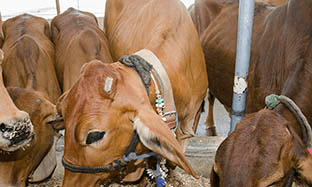Digestive strongyles
Digestive strongyles are inevitable in grazing cattle. It is primarily Ostertagia, the most common and the most pathogenic, but also Haemonchus, Cooperia, Nematodirus, and Oesophagostomum. All these roundworms pass through the mucosa of the abomasum, causing lesions, which lead to a drop in production, diarrhea and slimming.
Cattle become infected by ingesting larvae present in the grass of the field
Maintaining the immunity of cattle…
During first contact with aprasites, a young ‘naïve’ cattle is a true parasite multiplier. As it comes into contact, the cattle’s immune system gradually leads to the establishment of internal phenomena limiting the reproductive potential of the parasite. Thus, only 1% of the larvae ingested by an adult cattle become fixed and multiply, against 70% in young naïve cattle. It is therefore important to develop the immunity of cattle as soon as possible, by maintaining periods of contact with the parasite. After 2 years of grazing, cattle are considered to be immune and suffer less from the presence of pests on the plot.
and adapting the support.
During the 2 first years of grazing, young cattle are particularly sensitive to gastrointestinal strongyloses and it is necessary to adapt the management of parasitism. The management period at the time when moved to the field to graze should be considered, in other words not too early to allow the animals do develop immunity against the parasite, nor too late not to let the symptoms settle. For older animals, management is considered on a case-by-case basis, depending on the presence of clinical signs, reduced production, or pepsinogen dosing results.
Consult your vet to carry out the parasitism management plan adapted to your farm.



